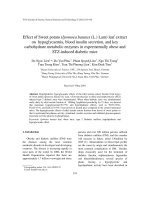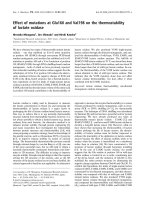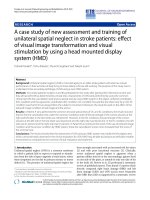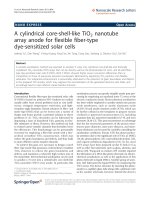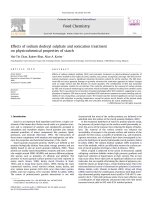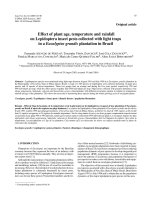Effect of dietary supplementation of chicory root powder and avian specific lactobacillus spp on the hematology, blood biochemical, lipid, enzyme and antioxidant profile of broiler birds
Bạn đang xem bản rút gọn của tài liệu. Xem và tải ngay bản đầy đủ của tài liệu tại đây (317.67 KB, 11 trang )
Int.J.Curr.Microbiol.App.Sci (2019) 8(10): 1511-1521
International Journal of Current Microbiology and Applied Sciences
ISSN: 2319-7706 Volume 8 Number 10 (2019)
Journal homepage:
Original Research Article
/>
Effect of Dietary Supplementation of Chicory Root Powder and Avian
Specific Lactobacillus spp on the Hematology, Blood Biochemical, Lipid,
Enzyme and Antioxidant Profile of Broiler Birds
David Lalthlamuana*, A. K. Samanta, L. Hmar, P. Behera, R. Buragohain,
M. Ayub Ali and V. P. Vaisakh
Department of Animal Nutrition, College of Veterinary Sciences and A.H., Selesih,
Mizoram, 796 014, India
*Corresponding author
ABSTRACT
Keywords
Chicory root
powder,
Lactobacillus spp,
Biochemical
parameters,
Haematology
Article Info
Accepted:
12 September 2019
Available Online:
10 October 2019
An experiment was conducted to assess the effect of dietary supplementation of chicory
root powder and avian specific Lactobacillus spp on blood biochemical and anti-oxidant
profile of broiler birds. 250 day old commercial (Ven Cobb) broiler chicks were selected
randomly and were distributed into five treatments groups. Duration of experiment was 42
days. Each treatment comprises of five replicates with 10 chicks in each replicate. Dietary
treatment consists of: Group1 - control (basal diet as per BIS, 2007), Group 2 - (basal feed
+ BMD 0.5g/kg), Group 3 - (basal feed + 1% chicory root powder), Group 4 - (basal feed
+ Lactobacillus spp), Group 5 - (basal feed + 1% chicory root powder + Lactobacillus
spp). Haematological parameters were not affected due to treatment imposed in the study
except PCV which was higher (P<0.05) in CRP+LB group. Serum SGPT was found to be
significantly decreased (P<0.01) in CRP & LB group at day 28, and average level in serum
SGOT was also observed to be significantly decreased (P<0.05) for all treatment groups as
compared to AGP group. Total protein value showed significant increased (P<0.05) in
CRP+LB group at day 42. Globulin level was observed to be significantly increased
(P<0.05) in CRP & CRP+LB group at day 42. Serum triglyceride level was significantly
decreased (P<0.01) for all the treatment group as compared to AGP group. Serum LDL
concentration was found to be significantly decreased (P<0.05) in CRP and CRP+LB
group as compared to control, AGP & LB group on day 42, and serum HDL level was
significantly increased (P<0.01) for all treatment group as compared to AGP group. The
anti-oxidant profile as indicated by FRAP value showed significant increase (P>0.01) in
CRP+LB group as compared to other treatment groups. Thus, the result from the study
suggests that chicory root powder and avian specific lactobacillus spp are both beneficial
feed supplement which can substitute antibiotic in the diet of broiler.
Introduction
Poultry production has undergone an
enormous expansion during the past decades
throughout the world (Praveen et al., 2017).
India's poultry industry has shown to grow at a
steady rate of around 7-8% per year
(Soundararajan, 2017). The poultry industry
1511
Int.J.Curr.Microbiol.App.Sci (2019) 8(10): 1511-1521
benefitted from the inclusions of antibiotic
growth promoters (AGP) in feed which
enhance the performance and health of broiler
birds (Awad et al., 2009).
Current trends in poultry production aim at
reducing the repeated use of antibiotic growth
promoters, and the use of alternatives to
antibiotic growth promoters because of
development of antimicrobial resistance, and
antibiotic residue in meat (Jackson et al.,
2004). Potential alternatives to antibiotics in
broilers are prebiotics and probiotics.
Probiotic
lactic
acid
bacteria
and
oligosaccharide have been showing positive
effect in the digestive tract of birds.(Spring et
al., 2000).
Chicory root (Cichorium intybus) is a source
of inulin & fructo-oligosaccharides (FOS)
considered as prebiotic. Research showed that
the addition of chicory root fructans either
inulin or oligo fructose to broiler feed
improved body weight gain, feed conversion,
carcass yield and increased the small intestine
length of female broilers (Yusrizal and Chen,
2003). Another feed additive is probiotics,
which are live microorganisms that have a
positive effect on the host by improving the
balance of pathogenic to beneficial bacteria in
the gut (Simon et al., 2001). The benefits of
probiotics are based on two main functions,
stimulating the growth of beneficial
microflora and suppressing the growth of
pathogenic bacteria.
Among different probiotics, Ghareeb et al.,
(2012) reported that the administration of the
probiotic
containing
avianspecific
Lactobacillus spp to broiler chickens can help
reduced C. jejuni by altering the gut
microbiota that is beneficial for the intestine
and provide protection against invasion from
harmful pathogens. The potential health
benefits associated with using a probiotics
include improved digestion, stimulation of
gastrointestinal immunity and increased
natural resistance to enteric disease (Tellez et
al., 2001).
When probiotic & prebiotic are used together
in the diet, they can help improve the
microbial count and viability of beneficial
microorganisms, since they can use prebiotics
as a substrate for fermentation in the GI tract
(Bengmark, 2001).
Therefore, this study was conducted with the
hypothesis that avian specific Lactobacillus
spp and chicory root inulin would have
beneficial effect on the blood biochemical
parameters and antioxidant profile of the
broiler birds.
Materials and Methods
Experimental design and diets
A total of 250 day old broiler chicks having
similar body weight from a single hatch were
purchased and distributed randomly into 5
treatment groups, with 50 birds kept in each
group following completely randomized
design. Each group consists of 5 replicate with
10 birds in each replicate. All the chicks were
reared under the same management and
condition. Due attention was adopted to
maintain the biosecurity and avoid stress
inside and outside the farm. Three types of
broiler diets were formulated and prepared i.e.
broiler pre-starter (1-7d), broiler starter (821d) feed and broiler finisher (22-42d) feed
as per specified by BIS (2007). Group 1
(CON) was fed standard basal diet without
any additional supplements. Birds in group 2
(AB) was fed basal diet with Antibiotic
Growth Promoters i.e. Bacitracin methylene
disalicylate (BMD) @ 0.5g/kg of feed. Group
3(CRP) was fed basal diet with chicory root
powder @ 1% of feed. Group 4 (LB) was fed
basal diet with avian specific Lactobacillus
spp at prescribed dose rate @106/g diet. Group
1512
Int.J.Curr.Microbiol.App.Sci (2019) 8(10): 1511-1521
5 (CRP+LB) was fed the basal diet with
combination of chicory root powder and avian
specific Lactobacillus spp. Chicory root
powder was purchased commercially from
Earth Expo Company, Gujarat, India and it
was incorporated in the diet at the rate of 1%
diet. Lactobacillus spp was isolated from
healthy broiler birds following standard
procedures and used as probiotic in the diet of
experimental birds. Birds were reared under
deep litter system of management. The
experimental birds were offered ad libitum
feed everyday using a clean feeder.
Vaccination against New Castle Disease
(NDV) & Infectious Bursal Disease (IBD) was
given on day 7 and day 14 respectively.
determined by using ferric reducing antioxidant power (FRAP) assay (Benzie &
Strain, 1996). The serum samples was then
run in U.V - Spectrophotometer. The value
obtained was expressed as Trolox equivalent
(10µgTE/10µl).
Statistical analysis
The statistical analysis of the recorded or
estimated data was done using standard
analytical procedure (Snedecor and Cochran,
1994). Differences among means were
separated using Duncan’s multiple range test
(Duncan, 1955). Probability values less than
0.05 is considered to be statistically significant
and values P≤ 0.01 was declared a trend.
Hematological examination
Results and Discussion
Blood was collected by sample vial (EDTA) at
day 42. Estimation of haematological
parameters like packed cell volume (PCV),
red blood cells (RBC), white blood cells
(WBC), hemoglobin (Hb), was done with the
help of automated haematology cell counter
(Model: MS4e) following the standard
procedures as per the manufacturer's protocol.
Biochemical indices examination
2ml of blood sample was collected in a vial
from all replicate of the treatment group from
the wing vein at day 28 and day 42. The
samples were left stand to clot for 30 min, and
then centrifuged at 3000 rpm for 10 mins to
separate the serum. The blood biochemical,
enzyme and lipid profile was determined using
Fujifilm clinical chemistry analyser as per
manufacturer’s protocol.
Anti – oxidant profile
Blood was collected in sample vial on day 28
and day 42, serum was collected by
centrifugation at 3000rpm for 10 mins. Anti –
oxidant profile for each treatment group were
Hematological parameters
Average values of blood WBC, RBC, PCV,
Hb level in different treatment groups at
different age are presented in table 1.
Statistical analysis revealed that there were no
significant (P>0.05) difference in the WBC &
RBC count and Hb level among the different
treatment groups at day 42. However, the
packed cell volume (PCV) was significantly
(P<0.05) increased at 42 days in CRP and LB
group as compared with control, AGP and
CRP+LB group. Similar finding have been
reported by Akoy (2015) who observed
increased level of PCV in treatment groups
diet supplemented with inulin and probiotic.
On contrary to our findings, Beski and AlSardary (2015) reported that supplementation
of fructooligosaccharide (FOS) and probiotics
(strain of Lactic Acid Bacteria) did not have
significant (P>0.05) effect on the PCV of
broiler birds. Hashem and Mohamed (2009)
also observed no significant (P>0.05)
difference in the PCV of broiler birds fed
inulin (5%diet) and probiotics (protexin
0.5g/L) in the diets of broiler birds. The
1513
Int.J.Curr.Microbiol.App.Sci (2019) 8(10): 1511-1521
increased PCV value in LB group could be
due to the probiotics of Lactobacillus spp
which might have reduced the nutritional
stress and maintaining a healthy gut status in
broiler birds (Karoglu and Drudag, 2005).
serum indicates better metabolism of proteins
in the body by providing feed additives (like
prebiotic MOS, FOS) in the diet (Burkhardt,
2000).
Lipid profile
Blood biochemical parameters
Blood biochemical parameters like glucose,
total protein, albumin and globulin
concentration on serum of different
experimental groups are presented in Table 2.
Glucose level showed no significant
difference (P>0.05) between the treatment
groups at both day 28 and day 42. Total
protein level was observed to be significantly
(P<0.05) different, with highest protein value
observed in CRP+LB groups at day 42.
The present finding is in consistency with the
findings of Mousa et al., (2017) who reported
significant increased in protein level on
supplementation with Cichorium intybus
and/or Moringa oleifera. However, the present
study is in conflict with Koksal et al., (2011)
could not observe any significant difference
(P>0.05) in total protein due to supplemental
inulin in the diet of broiler birds. Globulin
concentration was observed to be significantly
(P<0.05) increased in CRP & CRP+LB group
as compared to other groups.
The observed difference in globulin is
comparable
with
the
findings
of
Ashayerizadeh et al., (2009), Hashem and
Mohamed (2009) who observed significant
difference in the level of protein between the
treatment and control group.
However, the present findings is in
disagreement with the findings of, Yenge et
al., (2018) and Kowalczuk-Vasilev et al.,
(2017) who reported no significant difference
(P>0.05) in the level of globulin on
supplementation of inulin in the diet of broiler
birds. This change in total protein level in
The effects of chicory root powder and avian
specific lactobacillus spp treatments on serum
lipid profile of broiler birds during day 28 and
day 42 are presented in Table 3. Cholesterol
level showed no significant difference
(P>0.05) between all the treatment groups.
Triglyceride level was observed to be
significantly (P<0.05) decreased in CRP, LB
& CRP+LB group as compared to control and
AB group. The observed reduction is in
agreement with Yusrizal and Chen, (2003),
Ashayerizadeh et al., (2009) and Elrayeh et
al., (2011) who observed significant decreased
(P<0.01) in the level of triglyceride of broiler
birds supplemented with inulin and probiotic.
LDL and HDL showed significant decreased
(P<0.05) in CRP, LB &CRP+LB groups as
compared to control and AB group at day 42..
The observed significant difference (P<0.05)
in the level of LDL was in line with the
findings of Beski and Al-Sardary (2015) and
Kalavathy et al., (2010). The reduction in the
serum LDL might be due to the fact that, large
amount of LDL is made up of cholesteryl
esters and free cholesterol with little
triglycerides (Mc Eneny et al., 2002), and
treatment of both prebiotic and probiotic have
the ability to reduce the cholesteryl esters
level in LDL (Min-Tze Liong et al., 2007)
Serum enzyme
The effects of chicory root powder and avian
specific lactobacillus spp treatments on serum
enzyme of broiler birds during day 28 and day
42 are presented in Table 4.
1514
Int.J.Curr.Microbiol.App.Sci (2019) 8(10): 1511-1521
Table.1 Effect of chicory root powder and avian specific Lactobacillus spp on
hematological parameter
Treatment
Attribute
s
WBC
Group-1
(C)
6.26±4.80
RBC
2.33±0.26
PCV
29.20±0.43
Group- 2
(AGP)
6.93±8.35
Group- 3
(CRP)
6.96±3.92
Group- 4
(LB)
6.83±3.92
Group- 5
(CRP+LB)
6.93±2.90
0.85N
S
2.53±0.17
2.74±0.32
2.60±0.23
2.56±0.08
0.45
NS
b
a
31.03±1.23
a
33.40±0.51
a
31.93±0.37
b
Hb
P
value
14.40±0.66
a
0.02*
15.90±1.15
0.86N
31.40±0.70
b
15.30±1.60
15.66±0.86
15.20±0.41
S
CON- Control; AB- Antibiotic growth promoter; CRP- Chicory Root Powder; LB- Lactobacillus spp; CRP+LBChicory Root Powder & Lactobacillus spp; *Calculated value; a,b,c means with different superscripts in a row differ
significantly; NS= Non significant; * means (P<0.05); ** means (P<0.01); Avg- Average
Table.2 Effect of chicory root powder and avian specific Lactobacillus spp on serum enzyme
SGPT (U/I) & SGOT (U/I)
Treatment
Attribute
s
Group-1
(C)
Group- 2
(AGP)
Group- 3
(CRP)
Group- 4
(LB)
Group- 5
(CRP+LB)
P
value
SGPT
a
b
b
b
d 42
7.00±0.40
6.25±0.47
5.25±0.62
4.75±0.62
4.77±0.25
3.75±0.47
4.25±0.47
5.50±1.19
Average
6.62±0.44
d 28
d 28
d 42
a
bc
5.00±0.62
c
4.26±0.34
SGOT
ab
5.50±0.64
6.00±0.57
bc
4.87±0.81
ab
5.75±0.60
0.01**
NS
0.14
0.03*
a
b
a
a
a
164.25±11.6 204.50±9.36 167.00±8.87 171.00±0.57 170.50±7.96 0.02*
176.25±6.70 195.50±19.1 148.75±7.08 167.00±25.4 157.50±6.61 0.27NS
Average 170.25±8.68a 200.00±16.1b 157.87±7.02a 169.00±11.8a 164.00±1.98a 0.01**
CON- Control; AB- Antibiotic growth promoter; CRP- Chicory Root Powder; LB- Lactobacillus spp; CRP+LBChicory Root Powder & Lactobacillus spp; *Calculated value; a,b,c means with different superscripts in a row differ
significantly; NS= Non significant; * means (P<0.05); ** means (P<0.01); Avg- Average
1515
Int.J.Curr.Microbiol.App.Sci (2019) 8(10): 1511-1521
Table.3 Effect of chicory root powder and avian specific Lactobacillus spp on serum Glucose
(mg/dl), Total protein (g/dl), Albumin (g/dl) and Globulin (g/dl) in broiler chickens
Treatment
Attribute
s
d 28
d 42
Group-1
(C)
Group- 2
(AGP)
Group- 3
(CRP)
Group- 4
(LB)
Group- 5 P value
(CRP+LB)
Glucose
228.00±9.81 262.75±26.9 202.75±10.0 228.00±14.38 201.25±10.0 0.08NS
0
242.75±14.0 295.25±21.4 235.25±8.27 272.25±31.96 257.75±3.68 0.21NS
Average 235.37±10.4b 279.00±22.4a 219.00±8.90b 250.12±20.1ab 238.75±7.54b 0.03*
Total Protein
NS
3.17±0.17
3.02±0.08
3.12±0.17
3.12±0.11
3.17±0.08
d 28
0.92
c
bc
ab
bc
a
0.02*
d 42
3.05±0.09
3.37±0.06
3.52±0.26
3.32±0.10
3.85±0.09
Average
b
3.11±.09
b
ab
3.20±0.06
3.32±0.14
ab
a
3.51±0.07
0.01**
1.10±0.05
1.02±0.04
0.44
3.22±0.07
d 28
1.05±0.02
1.00±0.04
Albumin
1.12±0.07
d 42
1.02±0.09
1.07±0.04
1.05±0.09
1.05±0.05
1.25±0.05
0.21
Average
1.03±0.04
1.03±0.03
1.08±0.06
1.07±0.05
1.13±0.02
0.27
2.02±0.07
Globulin
2.00±0.10
2.02±0.06
d 28
2.12±0.16
d 42
2.02±0.13
2.07±0.07b
Average
b
2.30±0.07
2.16±0.05
ab
2.47±0.18
a
ab
ab
2.23±0.11
2.27±0.07
2.15±0.05
ab
ab
2.15±0.06
a
2.60±0.05
2.37±0.0 4a
NS
NS
NS
NS
0.78
0.03*
0.01**
CON- Control; AB- Antibiotic growth promoter; CRP- Chicory Root Powder; LB- Lactobacillus spp; CRP+LBChicory Root Powder & Lactobacillus spp; *Calculated value; a,b,c means with different superscripts in a row differ
significantly; NS= Non significant; * means (P<0.05); ** means (P<0.01); Avg- Average
1516
Int.J.Curr.Microbiol.App.Sci (2019) 8(10): 1511-1521
Table.4 Effect of chicory root powder and avian specific Lactobacillus spp on serum lipid :
Triglyceride (mg/dl), Cholesterol (mg/dl), LDL (Mg/dl) and HDL (mg/dl) in broiler chickens
Treatment
Attributes
Group-1
(C)
Group- 2
(AGP)
Group- 3
(CRP)
Triglyceride
b
d 28
a
53.00±3.69
d 42
b
48.50±5.83
50.75±4.30
a
65.75±3.63
a
b
47.75±50.75
b
0.01**
a
0.01**
a
0.01**
52.00±1.87
a
40.50±1.84
43.00±1.47
b
a
P value
Group- 5
(CRP+LB)
b
71.25±5.15
a
Group- 4
(LB)
42.75±3.40
a
Average
50.75±2.19
d 28
109.00±7.01
44.12±10.12
46.87±2.71
47.37±2.11
Cholesterol
116.75±7.57
113.25±5.57
102.00±6.28 109.00±1.47
d 42
109.25±6.22
110.25±10.94
102.50±3.27
100.75±0.47
104.25±0.85
0.72
Average
109.12±5.06
113.50±8.05
108.62±4.11
101.62±4.31
106.63±3.37
0.63
14.30±2.60
LDL
14.00±0.40
13.50±0.64
12.75±0.62
0.62
68.50±2.10
d 28
17.35±3.92
d 42
a
a
b
Average
18.75±2.39
18.05±1.26
18.80±0.71
16.55±1.23
12.00±0.40
13.00±0.36
d 28
83.00±5.11
90.75±2.17
d 42
a
b
a
a
a
84.75±4.53
83.87±3.46
72.50±3.86
81.62±1.78
94.75±1.54
94.25±2.73
92.25±5.02
89.87±4.51
87.50±0.64
88.25±2.34
Average
HDL
93.75±5.15
ab
15.75±1.49
14.62±1.02
87.50±5.67
NS
0.51
NS
NS
NS
b
11.75±0.47
12.25±0.36
89.00±9.32
0.02*
NS
0.053
NS
0.77
**
0.01
NS
0.11
CON- Control; AB- Antibiotic growth promoter; CRP- Chicory Root Powder; LB- Lactobacillus spp; CRP+LBChicory Root Powder & Lactobacillus spp; *Calculated value; a,b,c means with different superscripts in a row differ
significantly; NS= Non significant; * means (P<0.05); ** means (P<0.01); Avg- Average
Table.5 Effect of chicory root powder and avian specific Lactobacillus spp on
FRAP(10TE/10µl) value in blood serum
Treatment
Attributes
d 28
Group-1
(C)
1.14±0.07
Group- 2
(AGP)
1.39±0.12
Group- 3
(CRP)
1.20±0.07
Group- 4
(LB)
1.06±0.08
Group- 5
(CRP+LB)
2.08±0.54
d 42
1.35±0.05
1.62±0.12
1.38±0.06
1.27±0.05
2.26±0.51
Average
1.25±0.05
b
b
1.50±0.12
b
1.29±0.06
b
1.16±0.06
a
2.17±0.50
P value
NS
0.10
NS
0.08
0.01**
CON- Control; AB- Antibiotic growth promoter; CRP- Chicory Root Powder; LB- Lactobacillus spp; CRP+LBChicory Root Powder & Lactobacillus spp; *Calculated value; a,b,c means with different superscripts in a row differ
significantly; NS= Non significant; * means (P<0.05); ** means (P<0.01); Avg- Average
1517
Int.J.Curr.Microbiol.App.Sci (2019) 8(10): 1511-1521
The blood serum lipid was significantly (p ≤
0.05) decreased in SGPT and SGOT level at
day 28. Similar findings was observed by
Khodadadi et al., (2016) who observed
reduction in SGPT level when supplemented
with Cichorium intybus L. in the diet of broiler
birds. Kanjilal et al.,(2014) observed
significant decreased (P<0.05) in SGOT level
of broiler birds fed with probiotic (Protexin®).
However, the findings are in contrast with the
findings of Abdel Fatteh et al., (2009),
Hashem and Mohamed (2009) who observed
no effect on SGPT and SGOT supplemented
with probiotics (protexin 0.5g/L) and inulin
(5%diet) in the diet of broiler birds. The
observed SGPT and SGOT level maybe due to
the effect of inulin and probiotic which consist
of antioxidant and free radical scavenging
property that are effective in regulating the
serum liver enzyme like SGPT and SGOT
(Hassan and Yousef, 2010)
Anti – oxidant profile
Based on perusal of table 5, serum FRAP
value (10µgTE/10µl) was found to be non significant (P<0.05) among the treatment
groups at day 28 and day 42. However, FRAP
value in the treatment group was tended to be
increased on both 28th and 42nd day when
compared with control group, highest value
observed in CRP+LB group. Overall, the
average FRAP value was significantly
(P<0.01) higher in CRP+LB group when
compared with control, AGP, & LB groups.
The present findings are in agreement with
Sohail et al., (2011) and Shen et al., (2014)
who observed increased level of antioxidant
for treatment group as compared to control
group when supplemented with probiotic
mainly Lactic acid bacteria.
However, the present study disagree with the
finding of Capcarova et al., (2011) who
observed significant difference (P<0.05) in the
antioxidant level of broiler birds provided with
Lactic acid probiotic.
The increased antioxidant value maybe due to
chicory root inulin which can regulate
glutathione metabolism to enhance the
antioxidant defense, and regulate cellular
metabolism, where its deficiency can result in
oxidative stress (Wu and Luo, 2009).
Acknowledgements
The authors are thankful to College of
Veterinary Sciences & A.H., CAU(I), Selesih,
Mizoram for the facilities and financial
support provided to carry out this research
work.
References
Abdel-Fattah, F.A., and Fararh, K.M. (2009).
Effect of dietary supplementation of
probiotic, prebiotic and synbiotic on
performance, carcass characteristics,
blood picture and some biochemical
parameters in broiler chickens. Benha.
Vet. Med. J., 20: 9-23.
Ashayerizadeh, A., Dabiri, N., Ashayerizadeh,
O., Mirzadeh, K. H., Roshankefr, H.
and Mamooee, M. (2009). Effect of
dietary antibiotic, probiotic and
prebiotic as growth promoters, on
growth
performance,
carcass
characteristics and hematological
indices of broiler chickens. Pak. J.
Biol. Sci., 12: 52-57.
Awad, W. A., Ghareeb, K., Abdel-Raheem, S.
and Böhm, J. (2009). Effects of dietary
inclusion of probiotic and synbiotic on
growth performance, organ weights,
and intestinal histomorphology of
broiler chickens. Poult. Sci., 88(1): 4956.
Akoy, R. A. M. (2015). The effects of
probiotics, prebiotics and synbiotics on
1518
Int.J.Curr.Microbiol.App.Sci (2019) 8(10): 1511-1521
gut flora, immune function and blood
characteristics of broilers.
Benzie, I.F. and Strain, J.J. (1996). The ferric
reducing ability of plasma (FRAP) as a
measure of antioxidant powder: the
FRAP assay. Anal. Biochem., 239: 7076.
Burkhardt,
D.
(2000).
Klinikiniai
laboratoriniai tyrimai. Vilnius, 1:63.
Bengmark,
S.
(2001).
‘Pre-pro-and
synbiotics’. Curr. Opinion. Clinical.
Nutri.., 4(6): 571-579.
BIS. (2007). Bureau of Indian Standards.
Livestock feed and equipment systems
sectional committee, FAD 5.
Beski, S.S.M., and Al-Sardary, S.Y.T. (2015).
Effects of dietary supplementation of
probiotic and synbiotic on broiler
chickens hematology and intestinal
integrity. Int. J. Poult. Sci., 14(1): 31.
Collins, M.D. and Gibson, G.R. (1999).
‘Probiotics, prebiotics and synbiotics:
Approaches for modulating the
microbial ecology of the gut’. The
American J. Clini. Nutri., 69:10521057.
Capcarová, M., Weis, J., Hrncár, C.,
Kolesárová, A., Petruska, P., Kalafová,
A. and Pál, G. (2011). Effect of
probiotic supplementation on selected
indices of energy profile and
antioxidant status of chickens. J.
Microbiol. Biotechnol. Food. Sci.,
1(2): 225.
Duncan, D. B. (1955). Multiple range and
multiple F tests. Biometrics, 11(1): 142.
Elrayeh, A. and Yildiz, G. (2012). Effects of
inulin and b-glucan supplementation in
broiler diets on growth performance,
serum cholesterol, intestinal length,
and immune system. Turk. J. Vet.
Anim. Sci., 36(4): 388-394.
Fuller, R. (1989). Probiotics in man and
animals. J. Appl. Bacteriol., 66: 365378.
Ghareeb, K., Awad, W. A., Mohnl, M., Porta,
R., Biarnes, M., Böhm, J. and
Schatzmayr, G. (2012). Evaluating the
efficacy of an avian-specific probiotic
to reduce the colonization of
Campylobacter jejuni in broiler
chickens. Poult. Sci., 91(8): 18251832.
Hashem, M. A. and Mohamed, M. H. (2009).
Haemato-biochemical and pathological
studies on aflatoxicosis and treatment
of broiler chicks in Egypt. Vet. Ital.,
45(2): 323-337.
Hassan, H.A. and Yousef, M.I. (2010).
Ameliorating effect of chicory
(Cichorium intybus L.) supplemented
diet against nitrosamine precursorsinduced liver injury and oxidative
stress in male rats. Food Chem.
Toxicol., 48: 21-63.
Jackson, M.E., Geronian, I.K., Knox, A.,
McNab, J. and McCartney, E. (2004).
A dose-response study with feed
enzyme beta-mannanase in broilers
provided with corn-soyabean meal
based diets in the absence of antibiotic
growth
promoters.
Poult.
Sci.,
83:1992-1996.
Kalavathy, R., Abdullah, N., Jalaludin, S. and
Ho, Y.W. (2003). Effects of
Lactobacillus cultures on growth
performance, abdominal fat deposition,
serum lipids and weight of organs of
broiler chickens. Br. Poult. Sci., 44:
139-144.
Karoglu, M. and Durdag, H. (2005): The
influence
of
dietary
probiotic
(Sacchromyces
cerviciae)
supplementation
and
different
slaughter age on the performance,
slaughter and carcass properties of
broiler. Int. J. Poult. Sci., 4:309-316.
Koksal, B. H., Kucukersan, M. K., and Cakin,
K. (2011). Effects of L-carnitine
and/or inulin supplementation in
energy depressed diets on growth
1519
Int.J.Curr.Microbiol.App.Sci (2019) 8(10): 1511-1521
performance, carcass traits, visceral
organs and some blood biochemical
parameters in broilers. Rev. Méd. Vét.,
162(11): 519-525.
Kanjilal, G., Akanda, M.R., Hasan, M.M.I.,
Chowdhury, M.R., Islam, M.S.,
Howlader, M.M.R. and Hossain, M.A.
(2014). Potency of Protexin® (mixed
probiotics) on hematobiochemical
alteration of commercial broiler.
American Journal of Phytomedicine
and Clinical Therapeutics., 2: 650659.
Khodadadi,
M.,
Mousavinasab,
S.S.,
Khamesipour, F. and Katsande, S.
(2016). The effect of cichorium intybus
L. ethanol extraction on the
pathological and biomedical indexes of
the liver and kidneys of broilers reared
under heat stress. Rev. Bras. Cienc.
Avic., 18(3): 407-412.
Kowalczuk-Vasilev,
E.,
Grela,
E.R.,
Samolińska, W., Klebaniuk, R.,
Kiczorowska, B., Krusiński, R.,
Winiarska-Mieczan, A., Kępka, K. and
Kwiecień, M. (2017). Blood metabolic
profile of broiler chickens fed diets
with different types and levels of
inulin. Med. Weter. 73(12): 774-780.
Mc Eneny, J., Mc Master, C., Trimble, E.R.,
and Young, I.S. (2002). Rapid
isolation of VLDL subfractions:
assessment of composition and
susceptibility to copper-mediated
oxidation. J. Lipid Res., 43(5): 824831.
Min-Tze, L., Dunshea, F.R. and Shah, N.P.
(2007). Effect of synbiotic containing
Lactobacillus acidophilus ATCC 4962
on plasma lipid profiles and
morphology of erythrocytes in
Hypercholestrolaemic pigs on highand low-fat diets. Br. J. Nutr., 98: 736744.
Mikelsaar, M. and Zilmer, M. (2009).
Lactobacillus fermentum ME-3 - an
antimicrobial
and
antioxidative
probiotic. In Microbial Ecology in
Health and Disease, 21:1-27.
Mousa, M. A., Osman, A.S. and Hady, H.A.
(2017). Performance, immunology and
biochemical parameters of Moringa
oleifera and/or Cichorium intybus
addition to broiler chicken ration. J.
Vet. Med. Anim. Health., 9(10): 255263.
Praveen, T., Munegowda, T., Indresh, H.C.
and Jayanaik (2017). Effect of
Supplementation of Various Levels of
Inulin on Growth Performance,
Carcass
Characteristics
and
Survivability in Raja II Broilers. Int. J.
Curr. Microbiol. App. Sci., 6(9): 14701475.
Spring, P., Wenk, C., Dawson, K. A. and
Newman, K. E. (2000). The effect of
dietary mannan oligosaccharides on
cecal
parameters
and
the
concentrations of enteric bacteria in
the ceca of Salmonella- challenged
broiler chicks. Poult. Sci. 79:205–211.
Simon, O., Jadamus, A. and Vahjan, W.
(2001). Probiotic feed additiveseffectiveness and expected mode of
action. J. Anim. Feed Sci., 10:51-67.
Snedecor, G.W. and Cochran, W.G. (2004).
Statistical Methods, 1st East-West
Press edition Affiliated East-West
Private Ltd. New Delhi.
Sohail, M. U., Rahman, Z. U., Ijaz, A.,
Yousaf, M. S., Ashraf, K., Yaqub, T.
and Rehman, H. (2011). Single or
combined
effects
of
mannanoligosaccharides
and
probiotic
supplements on the total oxidants, total
antioxidants, enzymatic antioxidants,
liver enzymes, and serum trace
minerals in cyclic heat-stressed
broilers. Poult. Sci., 90(11): 25732577.
Shen, X., Yi, D., Ni, X., Zeng, D., Jing, B.,
Lei, M. and Xin, J. (2014). Effects of
1520
Int.J.Curr.Microbiol.App.Sci (2019) 8(10): 1511-1521
Lactobacillus plantarum on production
performance, immune characteristics,
antioxidant status, and intestinal
microflora
of
bursin-immunized
broilers. Canadian J. Microbiol.,
60(4): 193-202.
Saeed, M., Abd El-Hack, M. E., Alagawany,
M., Arain, M. A., Arif, M., Mirza,
M.A., Naveed, M., Chao, S., Sarwar,
M., Sayab, M. and Dhama, K. (2017).
Chicory (cichorium intybus) herb:
Chemical composition, pharmacology,
nutritional and healthical applications.
Int. J. Pharmacol., 13(4):351-360.
Soundararajan, C., Nagarajan, K., Prakash, M.
A., and Raja, R. A. (2017). Peromelia
in Country Chicken. Indian Vet. J,
94(1): 84-85.
Tellez, G., Petrone, V. M., Excorcia, M.,
Morishita, T.Y., Cobb, C.W. and
Villasenor, L. (2001). Evaluation of
avian-specific
probiotics
and
Salmonella enteritidis-, Salmonella
typhimurium,
and
Salmonella
heidelberg-specific antibodies on cecal
colonization and organ invasion of
Salmonella enteritidis in broilers. J.
Food. Prot., 64:287–291.
Van De Wiele, T., Boon, N., Possemiers, S.,
Jacobs, H., and Verstraete, W. (2007).
Inulin‐ type fructans of longer degree
of
polymerization
exert
more
pronounced in vitro prebiotic effects.
J. App. Microbiol., 102(2):452-460.
Yusrizal, Y. and Chen, T. C. (2003). Effect of
adding chicory fructans in feed on
fecal and intestinal microflora and
excreta volatile ammonia. Int. J. Poult.
Sci., 2(3): 188-194.
Yenge, G. D., Lonkar, V. D., Ranade, A. S.,
Patodkar, V. R., Mote, C. S., Bhalerao,
S. M., and Doiphode, A. Y. (2018).
Dietary
supplementation
of
combination of inulin and saponin on
egg yolk lipid and seum biochemical
profile in laying hens. Int. J. Sci. Env.
Tech., 7(5): 1711-1720.
Wu, Q. and Luo, H. (2009). Research
chemical
composition
and
pharmacological actions in Cichorium
intybus L. root of artificial plant. China
Practical Med.,4:212-213.
How to cite this article:
David Lalthlamuana, A. K. Samanta, L. Hmar, P. Behera, R. Buragohain, M. Ayub Ali and
Vaisakh, V. P. 2019. Effect of Dietary Supplementation of Chicory Root Powder and Avian
Specific Lactobacillus spp on the Hematology, Blood Biochemical, Lipid, Enzyme and
Antioxidant Profile of Broiler Birds. Int.J.Curr.Microbiol.App.Sci. 8(10): 1511-1521.
doi : />
1521
